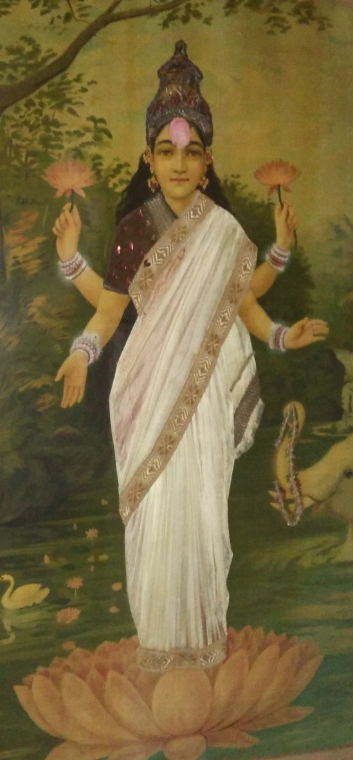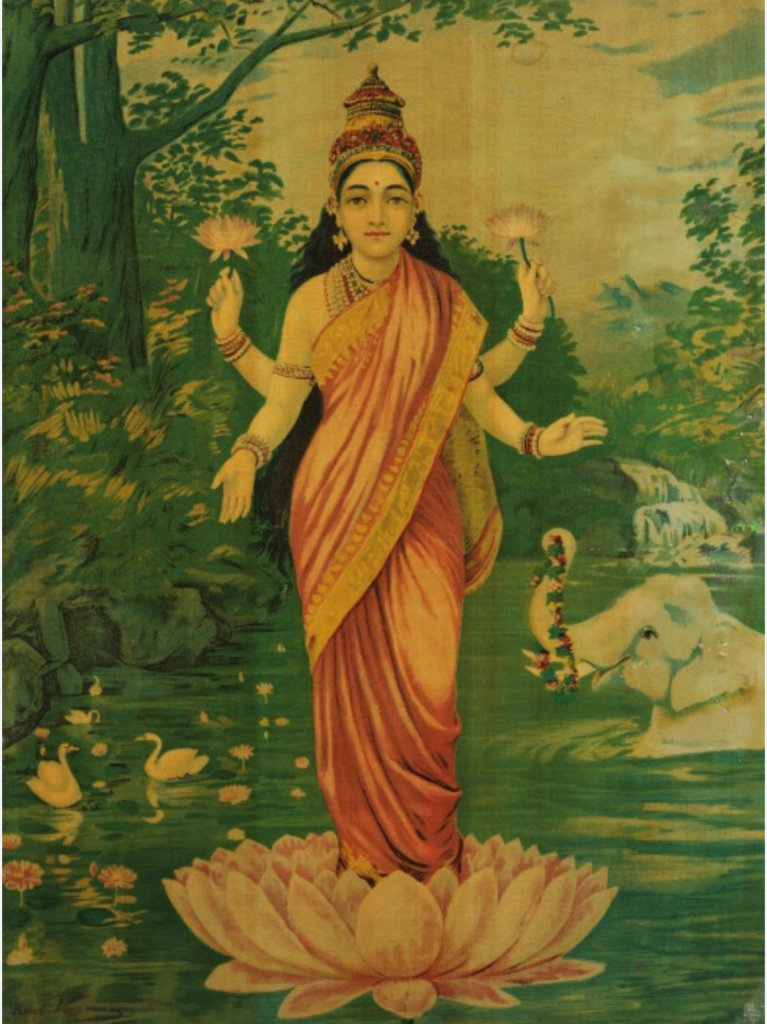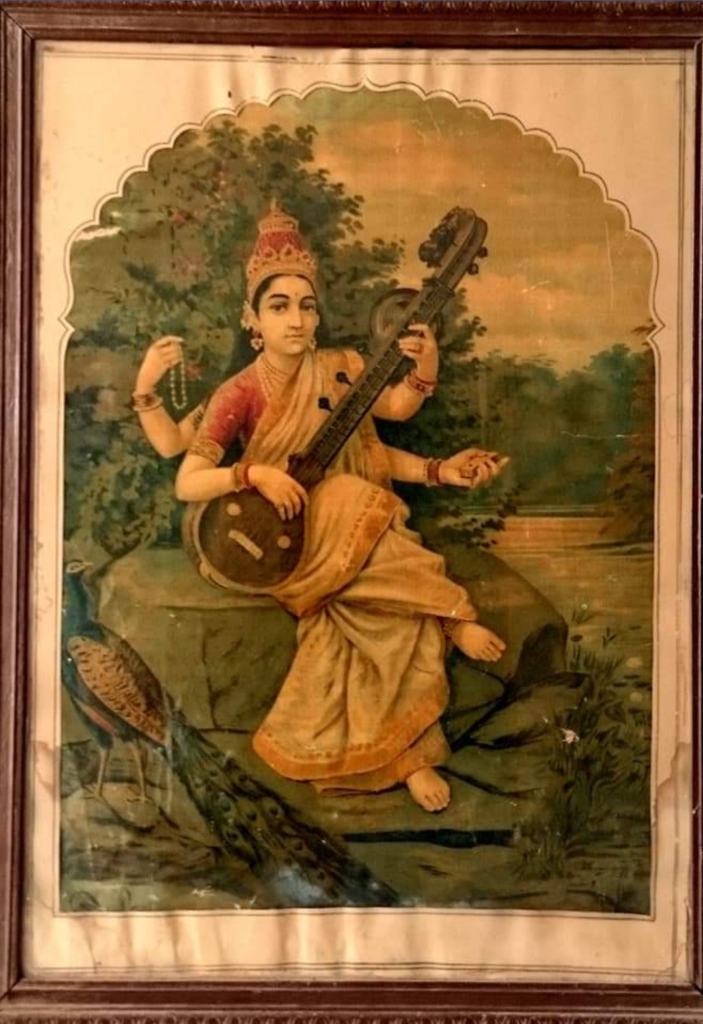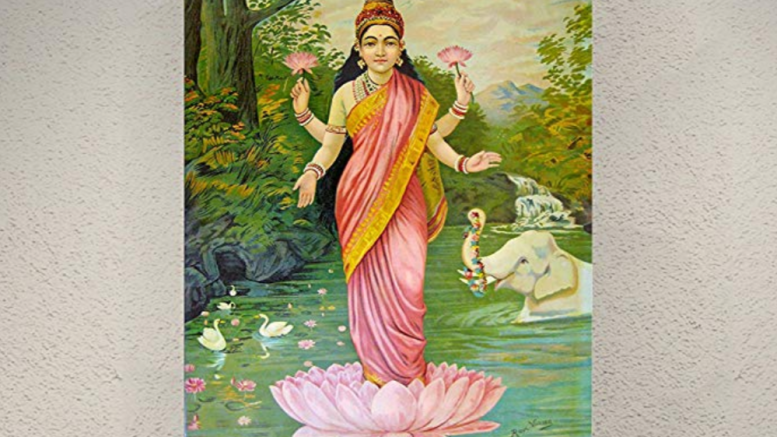

The image in this frame is a duplicate remake of the Original chromolithograph By Raja Ravi Varma first launched in 1894.

ORIGINAL RAJA RAVI VARMA’S PAINTING OF GODDESS SRI LAXMI DEVI (SHREE LAXSHMI MATA)In September, 1894, the chromolithographs of goddesses Lakshmi and Saraswati were launched ~ THE GODDESS OF WEALTH AND PROSPERITY (ESTIMATED COST 25 CRORE PLUS IN INTERNATIONAL MARKET) – PIC BY GPN/ FOR MORE INFORMATION ON THE WHEREABOUTS OF THE ORIGINAL MASTERPIECE IN INDIA CONTACT BY EMAIL : [email protected] / WhatsApp Mobile No : +91 9768497333 / +91 8108510506 / +91 8369388645
MUMBAI, 6 AUGUST, 2019 (GPN) : Raja Ravi Varma is perhaps one of the most widely known Indian painters, While his mythological paintings are a biggest pull factor, it is also a fact that he was a painter much ahead of his times who brought awe inspiration to the Indian art scenario by takings risks that none was willing to take.Born in 1848 on 29th April, Varma died at a young age of 58 in 1906 and in 2017 is considered one of the greatest painters of the Indian art scene.
His ability to create a perfect fusion between European technique and an Indian touch without going too heavy on either of the two styles is something artists and art critics still marvel at. After his style, it is Varma’s lithographs that are even still going strong, so much so, that in today’s time one cannot hope to get an original Raja Ravi Varma. According to certain sources, a Raja Ravi Varma original can go for as high as INR 30 cr or more.
Raja Ravi Varma was one of the few artists who attained professional success during his lifetime – for generally, it is opined that artists achieve great fame after their demise. It was the repeated demand for copies of his paintings which led to the suggestion by Dewan Sir Tanjavur Madhava Row that Ravi Varma send some of his paintings to Europe to have them oleographed. Sir Madhava prophesied that doing so would not only extend Varma’s reputation but would also do a great service to the country. Both these prophecies would come true in ample measure. The brother of Raja Ravi Varma, Raja Raja Varma would commence the logistic process of the establishment of the Press by deputing Abdoola Hoosein who traveled to Germany and engaged the services of Fritz Schleicher to help set up and run the Press. The Ravi Varma Fine Art Lithographic Press was set up in Girgaum, Bombay and commenced its operations. The first chromolithograph, ‘Birth of Shakuntala’ (also bears the spelling ‘Sakoontala’) was launched in July, 1894.
In September, 1894, the chromolithographs of goddesses Lakshmi and Saraswati were launched. The image in the frame at bottom is a later re-print of the chromolithograph first launched in 1894. The Lakshmi and Saraswati chromolithograhs were revolutionary for their time and ranked as No.1 (Numero Uno). It must be remembered that in 1894, access to religious methods and places of worship were severely restricted to certain classes of society. The process of opening temples to the masses commenced only in the 1930’s and was substantially set in motion by the Temple Entry Proclamation of Travancore in 1936. The Lakshmi and Saraswati chromolithographs breached every religious injunction and restriction by making their way into every Hindu home thereby democratically offering Hindus across all classes and castes access to uniform religious imagery.
It was these very lithographs that introduced the common people to the fine arts and the fact that Varma also made these lithographs affordable to the public really helped to raise his stature among the common people.While there is no denying that now we consider Ravi Varma as a great painter, however, the society of his time was not of the same mindset.
Varma faced a lot of criticism and social stigmafor not just painting semi-nude paintings of women but he was also one of the first Indian artists to give a face to Gods and Goddesses.
Before that, Gods and Goddesses were not painted in such detail, however, Varma dared to go beyond the set thinking and now his paintings of Lakshmi, Sarasvati and more some of the most accepted and loved works of Indian divine figures.
His muse, Sugandha who was the one to pose nude for many of Varma’s paintings was also cause of many whispers among the society at that time, due to the controversial nature of the paintings.
Varma did not stop there though, a big reason why he got in so much trouble was due to him paintingsemi-nude paintings of mythical characters like Rambha and Urvashi which also got him charged at the Bombay High Court for hurting religious sentimentality and encouraging obscenity. But the case was not able to do any damage considering Varma ultimately won the case and still went on creating his art.
The very fact that Varma continued creating his art even after getting so much social ostracization, is evidence of his courage and determination to provide his creations to the world.
His paintings might have dealt with controversial matters, but he was perhaps one of the first feminist painters of India if one looks at the way he made the female protagonist always stand out.
Even if one takes the paintings with male figures in them, it is always the female who takes center stage and catches the eye, and no she is not nude in all of his paintings.
Varma is also now applauded for capturing the royal court life and era in his paintings in a way no other artist could and in a rapidly changing time when people were forgetting what the courtly culture was.Varma was also commended for his ability to keep a traditional touch to his paintings whilst keeping his aesthetic quite astonishingly modern. Which was not something many other artists were able to do easily.
Art observers also argue that what is art if it does not change something within you and Raja Ravi Varma’s art definitely seems to do that.
Thus one could actually appreciate his artistic talents and recognise how daring and courageous he was in tackling tabooed subjects.


ENDS


Be the first to comment on "Raja Ravi Varma Masterpiece Oleograph paintings auctioned in Million Crore rupees – Be the Proud owner of the No.1 Original chromolithograph By Raja Ravi Varma"